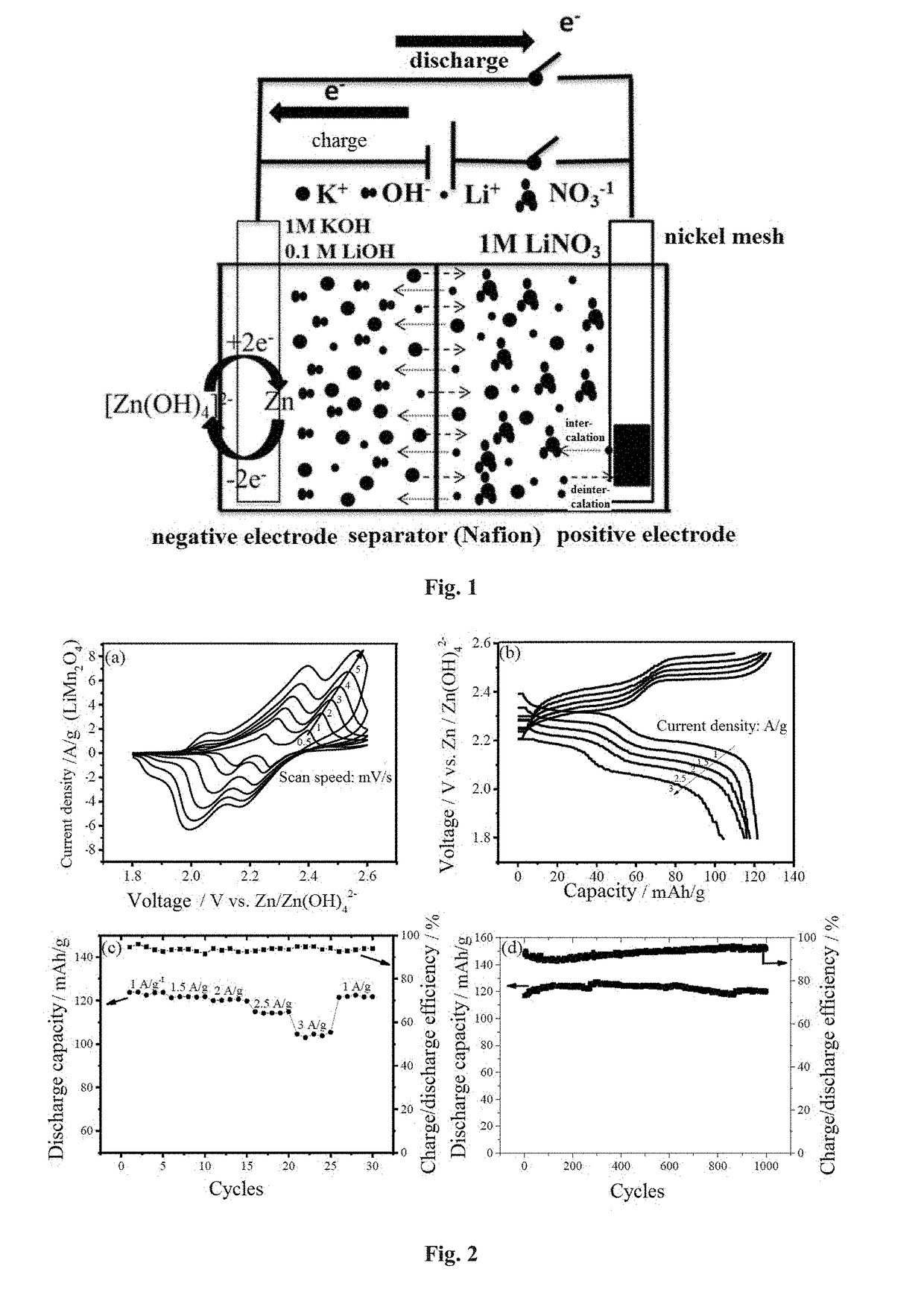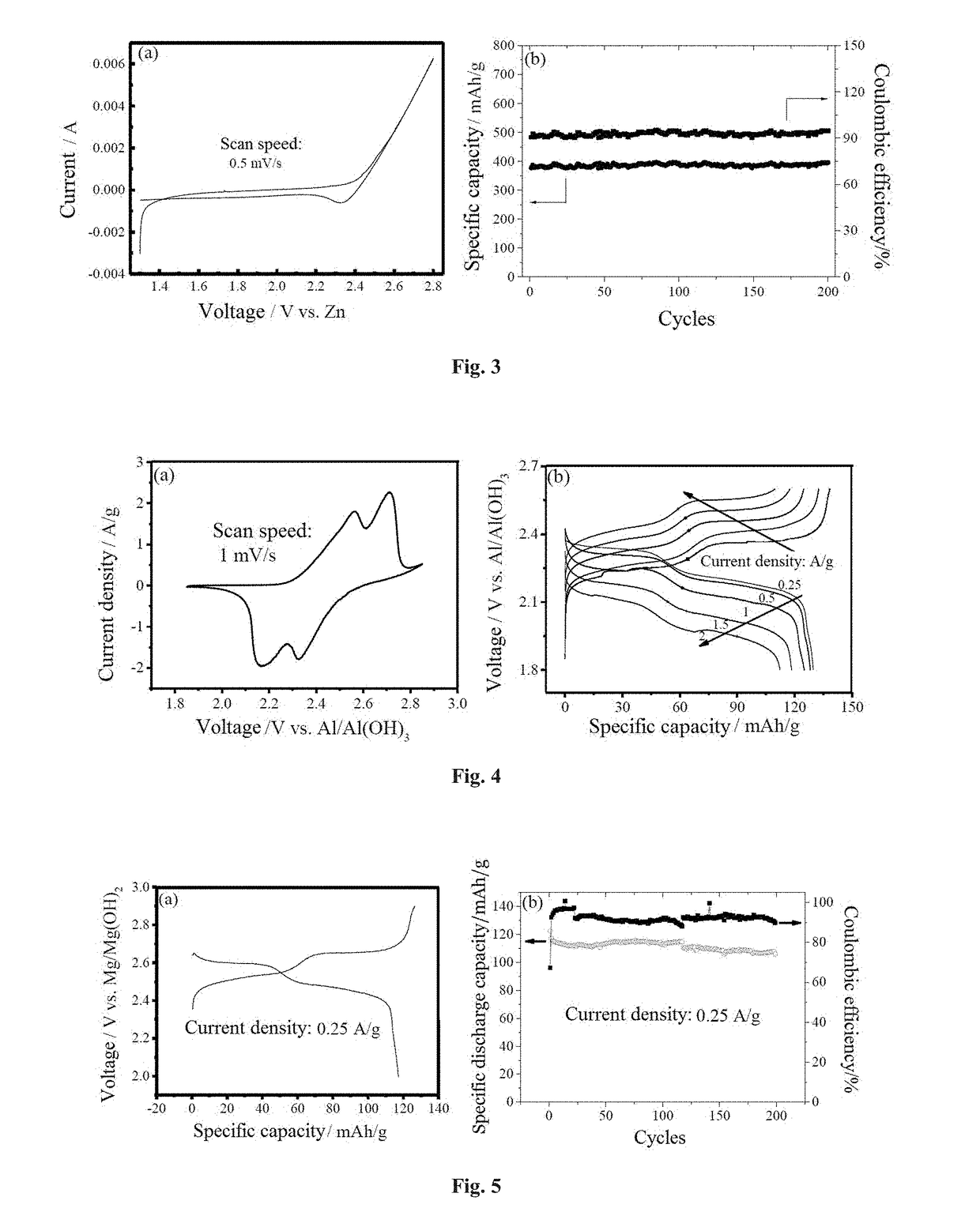Hybrid aqueous rechargeable battery
a rechargeable battery and hydrogel technology, applied in the field of batteries, can solve the problems of high production cost, difficult to increase the theoretical decomposition voltage of water and the working voltage of rechargeable batteries using hydrogels, and difficult to meet the requirements of assembly environment, etc., to achieve excellent stability and cycling performance, high working voltage, and high energy density
- Summary
- Abstract
- Description
- Claims
- Application Information
AI Technical Summary
Benefits of technology
Problems solved by technology
Method used
Image
Examples
example 1
[0057]Metal zinc as the negative electrode, LiMn2O4 with a reversible capacity of 120 mAh / g as the active positive electrode material, Super-P as the conductive agent, polyvinylidene fluoride as the binder, and anhydrous ethanol as the solvent are stirred into a homogeneous paste, and then coated on a stainless steel mesh to prepare a positive electrode piece. Nafion 117 membrane (DuPont, USA) is used as the separator, and the negative electrode side is a mixed aqueous solution electrolyte of 1 mol / L KOH / 0.1 mol / L LiOH, and the positive electrode side is an aqueous solution electrolyte of 1 mol / L LiNO3. After sealing, a chargeable / dischargeable aqueous lithium battery with LiMn2O4 as the positive electrode and Metal zinc as the negative electrode is obtained. Charge / discharge performance and cycling tests are performed. According to the test results, the average discharge voltage and the energy density obtained from the weight of the active material of the electrode are obtained. ...
example 2
[0059]Metal zinc as the negative electrode, LiFePO4 with a reversible capacity of 140 mAh / g as the active material of positive electrode, Super-P as the conductive agent, polyvinylidene fluoride as the binder, and anhydrous ethanol as the solvent are stirred into a homogeneous paste, and then coated on a stainless steel mesh to prepare a positive electrode piece. ASTOM cationic membrane (Shanghai Dingcheng Trading Co., Ltd.) is used as the separator, and the negative electrode side is a mixed aqueous solution electrolyte of 1 mol / L KOH / 0.1 mol / L LiOH, and the positive electrode side is an aqueous solution electrolyte of 1 mol / L LiNO3. After sealing, a rechargeable lithium ion battery with LiFePO4 as the positive electrode and metal zinc as the negative electrode is obtained. Tests are conducted at a current density of 1 A / g, wherein the charge cut-off voltage is 2.4 V, and the discharge cut-off voltage is 1.2 V. Again, according to the test results, the average discharge voltage and...
example 3
[0061]Metal zinc as the negative electrode AB / δ-MnO2 (AB is acetylene black) as the active positive electrode material, Super-P as the conductive agent, polyvinylidene fluoride as the binder, and anhydrous ethanol as the solvent are stirred into a homogeneous paste, and then coated on a graphite electrode to prepare a positive electrode piece. Nafion 117 membrane (DuPont, USA) is used as the separator, and the negative electrode side is an aqueous solution electrolyte of 6 mol / L KOH, the positive electrode side is a mixed aqueous solution electrolyte of 0.1 mol / L Br2 and 1 mol / L KBr, and the current collector is a graphite rod. After sealing, a novel Zn—Br2 battery is obtained. Charge / discharge performance and cycling tests are performed. Again, according to the test results, the average discharge voltage and the energy density obtained from the weight of the active material of the electrode are obtained. For convenient comparison, these data are also summarized in Table 1. Its CV c...
PUM
 Login to View More
Login to View More Abstract
Description
Claims
Application Information
 Login to View More
Login to View More - R&D
- Intellectual Property
- Life Sciences
- Materials
- Tech Scout
- Unparalleled Data Quality
- Higher Quality Content
- 60% Fewer Hallucinations
Browse by: Latest US Patents, China's latest patents, Technical Efficacy Thesaurus, Application Domain, Technology Topic, Popular Technical Reports.
© 2025 PatSnap. All rights reserved.Legal|Privacy policy|Modern Slavery Act Transparency Statement|Sitemap|About US| Contact US: help@patsnap.com



